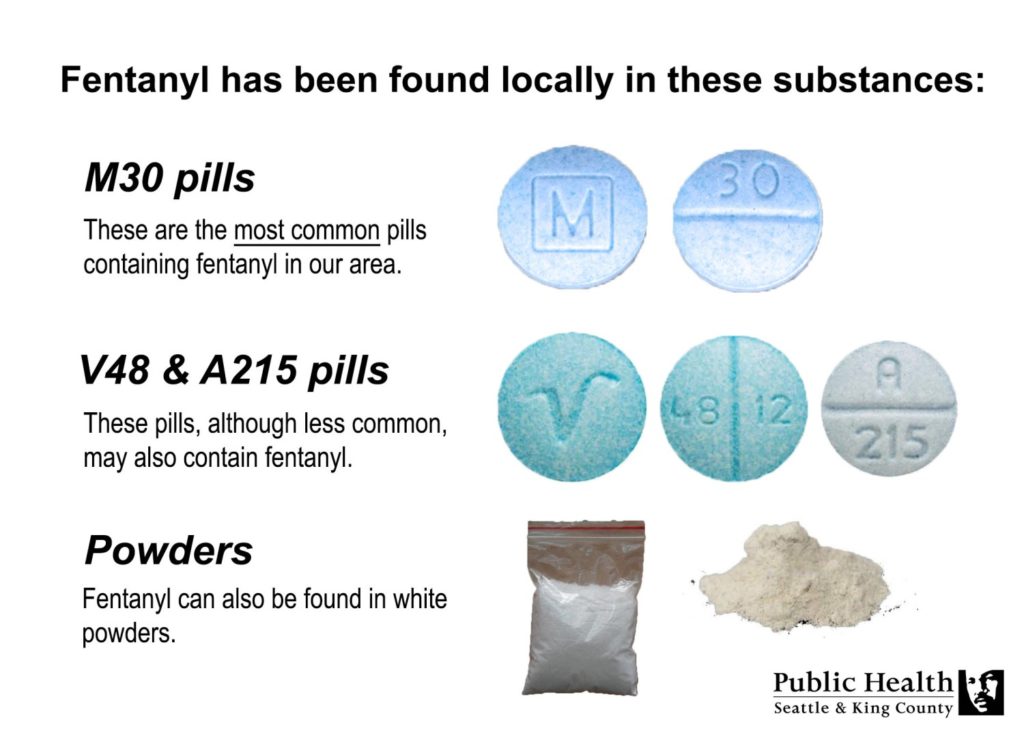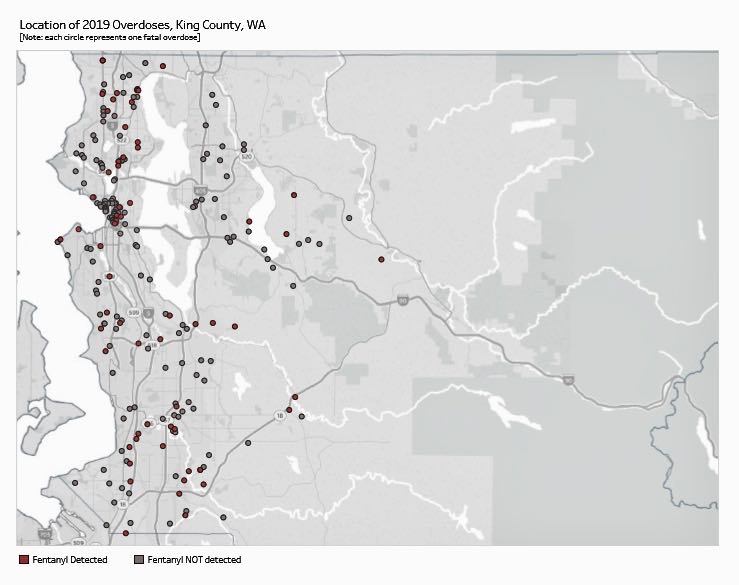Overdose update: Recent increase in overdose deaths linked to fentanyl-laced pills and powders

By James Apa, Public Health – Seattle & King County
Recent increases in King County overdose deaths, driven primarily by fentanyl found in illicit pills and powders, are prompting new outreach to alert people to the risks of illicit drug use.
Ongoing monitoring by Public Health — Seattle & King County using King County Medical Examiner’s Office data has detected a recent increase in drug overdose deaths. Between mid-June to mid-September 2019, 141 suspected and confirmed drug overdose deaths have occurred, compared to the 109 overdose deaths that occurred in this same period in 2018.
The overdose increases are being driven by both new and ongoing trends:
- Among people who are housed, fentanyl deaths are increasing, following a rise from 23 deaths in 2016 to 63 so far in 2019, with many cases pending investigation. Recent deaths have been by fake pills and powders laced with fentanyl; these deaths have been geographically spread across the county (see map below).
- In addition, trends reported previously persist in 2019: most overdose deaths are attributed to poly-substance use with methamphetamine-involved overdose deaths continuing to rise.
Findings released earlier this year showed that drugs and alcohol caused the overdose deaths of 415 King County residents for all of 2018, with 77% by multiple substances.
“This increase in fentanyl-associated deaths among people using illicit opioid pills and powders is alarming,” said Dr. Jeff Duchin, Health Officer for Public Health – Seattle & King County. “Fentanyl is a drop-dead drug — anyone using illicit opioid pills or powder should seek treatment for opioid use disorder and take precautions to prevent a fatal overdose.”
What people can do
Everyone should be aware of the risks associated with illicit drug use, and particularly the recent increase in fatal fentanyl overdoses:
- Do not consume any pill that you do not directly receive from a pharmacy or your prescriber.
- Pills purchased online are not safe.
- Counterfeit pills purchased illicitly may contain fentanyl and appear to be legitimate pharmaceutical products, such as oxycodone pills.
Anyone can help prevent a fatal overdose:
- Carry naloxone, the medication to reverse an opioid overdose. Visit stopoverdose.org for locations that provide naloxone.
- Do not use illicit substances alone.
- Call 911 if you witness an opioid overdose. If you are trying to help in an overdose, the Washington State Good Samaritan law protects you and the overdose victim from drug possession charges.
- Get rid of unused or expired medications. Find a dropbox near you: www.medicinereturn.org
Treatment works:
- Medication is available in the community that can cut
overdose risk in half and treat urges and cravings. - Call the 24-hour Recovery Help line: 1-866-789-1511 or visitwww.warecoveryhelpline.org
Addressing the epidemic
In response to the recent increase in overdose deaths, Public Health is alerting people at greatest risk through broad public announcements as well as focused channels. Materials will be distributed through needle exchange networks, as well as other partners, such as treatment centers, jails, emergency rooms and first responders.
Expanding access to medications: King County continues to expand access to medications for opioid use disorder, which is the most important way to help those at risk for a fatal opioid overdose.
There are over 100 locations across King County where people can receive medication for opioid-use disorder. Among Medicaid-covered patients, buprenorphine prescriptions in King County have increased from 739 in 2014 to over 5,000 in 2018.
Innovative treatment models for opiate use disorder are being established and expanded by King County:
- A street medicine team was created to provide treatment outreach and health care at shelters and encampments in Seattle.
- Buprenorphine Pathways, a proven low-barrier buprenorphine program located at the Downtown Public Health Center, continues to increase capacity.
- Treatment will be expanded in the King County Jail to include people starting their prescriptions in the facility. Since June 2018, over 500 people have received continuation of buprenorphine treatment in jail for their existing prescriptions.
- Local hospital emergency departments are changing their practices to become access points for buprenorphine.
Distributing naloxone and reversing overdoses: During the past two years, King County has increased access to naloxone among law-enforcement officers, treatment providers, and directly to the public through public health needle exchange sites. In 2018, over 20,000 naloxone kits were distributed and at least 5,000 overdoses were reportedly reversed using naloxone, and the total number of reversals is likely higher.
In August 2019, the Washington State Department of Health issued a statewide order to allow any person or organization to obtain naloxone medication from a pharmacy without a prescription.

Working upstream to address opioid and methamphetamine use: Unlike for opioids, there are not medication options to treat stimulant use that are proven effective. However, people reducing their opioid use through treatment who are also using methamphetamine may gain stability that allows them to reduce their methamphetamine use as well. Behavioral therapies can be effective for helping people quitting methamphetamine.
Methamphetamine and other illicit substance use are often related to adverse social and environmental conditions. A comprehensive prevention approach must address the underlying social, economic, and psychological stressors driving substance use disorders and addiction, including economic hardship and poverty; housing instability and homelessness; behavioral health disorders including depression and anxiety; discrimination and racism; and adverse child experiences and trauma.

